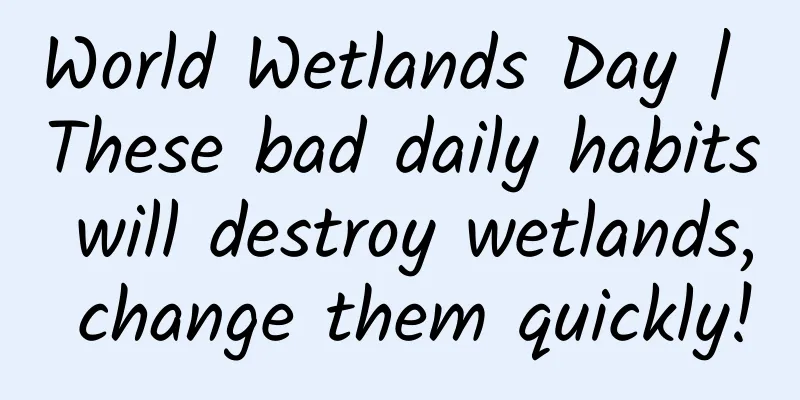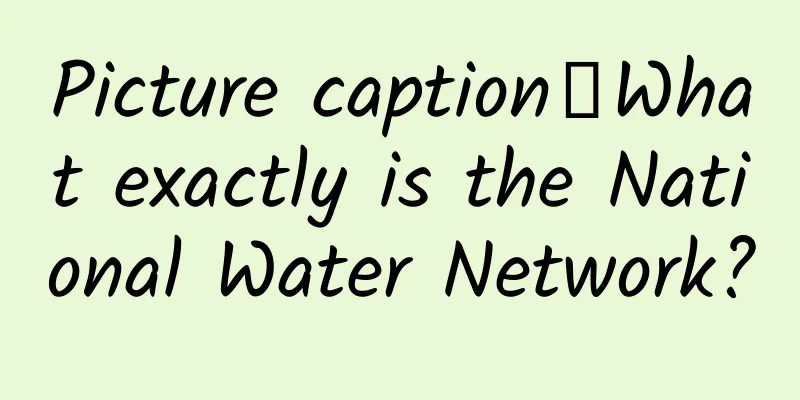World Wetlands Day | These bad daily habits will destroy wetlands, change them quickly!

|
If you stroll in the countryside, you will be mesmerized by the beautiful scene of lotus leaves and frogs croaking by the lake; if you wander in the city's water park, the sparkling water, birdsong and fragrance of flowers will surely make you feel relaxed and happy. These water-themed places are the indispensable and precious treasures in our lives - wetlands. However, while we enjoy the beauty brought by wetlands, some inadvertent daily behaviors may quietly damage this precious natural resource. 01 Wetland : One of the three major ecosystems The definition of wetland in the Chinese Dictionary is very concise: "Land rich in soil moisture (such as swamps and peatlands)". The International Convention on Wetlands defines it as: "Natural or artificial, permanent or temporary swamps, peatlands or water areas with static or flowing, fresh, brackish or salt water, including waters with a depth of no more than six meters at low tide." The "Wetland Protection Law of the People's Republic of my country" which came into effect on June 1, 2022 stipulates: "Wetlands as referred to in this Law refer to natural or artificial, perennial or seasonal waterlogged areas and waters with significant ecological functions, including sea areas with a water depth of no more than six meters at low tide, but excluding paddy fields and artificial waters and tidal flats used for aquaculture." Obviously, wetlands cover a wide range, including naturally formed rivers, lakes, swamps, tidal flats, etc. In the human body, the kidneys are important organs for regulating water balance. For the earth, wetlands also shoulder similar responsibilities and play a very important role in maintaining ecological balance. That is why people figuratively call wetlands "the kidneys of the earth" and call them one of the world's three major ecosystems along with forests and oceans. 02Functions of Wetlands There are many types of wetlands and many functions, but in summary, they mainly include the following aspects: (1) Flood prevention. The lower reaches of large rivers are usually low-lying and the river channels are wide. Floodplain wetlands act as natural regulators, dispersing the water, thereby reducing the water depth and flow rate, and reducing the occurrence of destructive flood disasters. For example, Poyang Lake in northern Jiangxi Province has a vast area, but the lake water level varies greatly with the seasons. When the water level is the highest, the area can exceed 4,000 square kilometers, but during the dry season, the lake surface can even shrink to one-tenth of its original size. Its huge flood storage capacity can effectively regulate the water level of the middle and lower reaches of the Yangtze River, thereby protecting more than 20 million people in the surrounding area from flood disasters. (2) Regulating the climate. The evaporation of water from wetlands can make the surrounding air more humid and regulate the local climate. More importantly, wetland plants can also absorb carbon dioxide through photosynthesis, thereby reducing the content of greenhouse gases in the atmosphere. Scientists have calculated that the global wetland area only accounts for 5% to 8% of the total land area, but they account for 35% of the total global terrestrial carbon pool, playing an irreplaceable role in mitigating the global greenhouse effect. Xixi Wetland Park in Hangzhou, Zhejiang (Photo source: Xinhua News Agency) (3) Purify sewage. Many aquatic plants have the ability to remove harmful substances from the water. While absorbing nutrients, they also absorb and filter heavy metal elements, which are concentrated in their roots, stems, leaves and other parts. In the east of Kolkata, India, there is a natural wetland covering an area of about 125 square kilometers. After people's domestic sewage is discharged here, it undergoes natural sedimentation and purification, and then is introduced into fisheries or into farmland for irrigation. In this way, Kolkata has built the world's largest wastewater utilization system, which can recycle about 90% of the city's wastewater. (4) Beautify the environment. Different wetlands present different natural landscapes. Currently, countries around the world have established wetland reserves or wetland parks, not only to protect wetlands, but also to present their most beautiful side to people. For example, the Liaohe River Delta in Liaoning Province is a wetland with a total area of nearly 6,000 square kilometers, where many saltwort sedges grow. They are tenacious and colorful, and they change from pink to fiery red and finally to purple-red with the change of seasons. Whenever the tide recedes, these saltwort sedges are like corals emerging from the water, covering the water surface, which is beautiful. Two red-crowned cranes foraging in Liaohekou National Nature Reserve (Photo source: Xinhua News Agency) (5) Nourishing life. More than 40% of the world's species depend on wetlands for reproduction and survival, including invertebrates, fish, amphibians, birds and other wildlife. Rare waterfowl often use wetlands as breeding and wintering grounds. The quality of wetlands directly affects the number of waterfowl. The Ordos Wetland in Inner Mongolia, my country, was originally a habitat for many migratory birds, but since 2006, due to the shrinkage of its area, the number of endangered species, the relict gull, has dropped sharply and almost disappeared. By 2019, the wetland function has gradually recovered, and a large number of relict gulls have returned home, which is a pleasant surprise. Ordos Relict Gull National Nature Reserve, relict gulls playing on the rippling lake (Photo source: Xinhua News Agency video screenshot) 03Fragile Wetlands Wetlands are very fragile. With the increase in human population and the intensification of global climate change, the impact and damage to wetlands are becoming more and more obvious. The Everglades National Park in southern Florida, USA, was originally a vast wetland with an area of about 23,310 square kilometers, with abundant biological resources. Since 1880, people have built canals and drained water here and developed wasteland, causing a sharp decrease in the wetland area and forcing many wild animals to migrate. In 1993, it was listed as an endangered world heritage site. Later, with people's efforts to restore it, it was removed from the "endangered" list in 2007. Who knew that the good times would not last long. Just three years later, it was listed as an endangered world heritage site again, which is really worrying. In order to protect wetlands, the Standing Committee of the Ramsar Convention has designated February 2 of each year as World Wetlands Day since 1997. This year's February 2 is the 29th World Wetlands Day, with the theme of "Protecting Wetlands, Building a Better Future", which aims to emphasize the importance of wetland protection and encourage all sectors of society to work together to contribute to wetland protection. Everglades National Park in Florida, USA (Photo source: Xinhua News Agency) 0 4 Everyday behaviors that damage wetlands my country's Wetland Protection Law clearly prohibits the destruction of wetlands and their ecological functions, but many people think that this is only the responsibility of the government or enterprises and has nothing to do with their daily lives. In fact, some of our daily bad behaviors may also unknowingly destroy precious wetland resources. There are mainly the following aspects: (1) Unauthorized introduction of alien species or release of animals. Some people, out of goodwill or personal interest, release non-native fish, turtles or other aquatic animals into wetlands. However, these alien species may adapt to the new environment and reproduce rapidly, competing with local species for food and habitat, or even preying on local species, causing a decrease in the number of local species or extinction. In China, some people have released non-native red-eared sliders and golden apple snails into natural wetlands. Abroad, the artificial introduction of Burmese pythons into the Everglades National Park in the United States has caused serious damage to the ecological balance. The famous invasive species "Brazilian Squirrel" (Photo source: Xinhua News Agency) (2) Capturing wild animals. In nature reserves and other important habitats where water birds are protected, some people ignore regulations and engage in illegal fishing, or engage in activities such as digging for benthic organisms, picking up bird eggs, and destroying bird nests. This not only directly threatens the survival and reproduction of water birds, but may also destroy the ecological balance of wetlands. For example, during the migratory season of migratory birds, some people set up bird nets in wetlands, which seriously interferes with the normal migration and reproduction of birds. Therefore, when conducting bird watching, scientific research, and popular science activities, we should maintain a safe distance to avoid affecting the normal foraging and reproduction of birds. (3) Excessive harvesting of wild plants. Illegal cutting of reeds and grass in wetlands may seem harmless, but in fact they may damage the regeneration capacity of wild plants and destroy the habitat of wild animals. (4) Applying pesticides or baits. Some people place pesticides or baits in wetlands in an attempt to control the number of certain organisms or attract certain species of organisms. However, these actions will disrupt the ecological balance of wetlands and may also accidentally harm other innocent organisms. For example, in some areas, excessive spraying of pesticides to control mosquitoes has led to the death of other insects and birds in wetlands. In the Norfolk wetlands in the United Kingdom, excessive use of pesticides caused a sharp decline in plant and animal populations in the wetlands. (5) Unauthorized movement of wetland protection signs or wetland park boundary markers. Some people deliberately damage, alter or move wetland protection signs and boundary markers to facilitate their own entry and exit of wetlands or to conduct illegal activities. Such behavior not only violates laws and regulations, but may also lead to blurred boundaries of wetland protection areas and increase management difficulties. (6) Camping in wetland parks where camping is prohibited. Some tourists, seeking excitement or convenience, set up tents, cook with fire, and litter in wetland parks where camping is prohibited. These behaviors may damage the vegetation and soil structure of the wetland. Some off-road vehicle enthusiasts also drive their vehicles over vegetation in wetland areas, resulting in the destruction of wetland vegetation, soil exposure, and water loss. Beijing Nanhaizi Wetland Park (Photo: Ma Zhifei) We are all responsible for protecting wetlands. Let us start with ourselves, start now, consciously resist all bad behaviors that damage wetlands, and jointly protect this precious natural resource so that the ecological beauty of wetlands can continue and be passed down from generation to generation. Author: Ma Zhifei, a popular science writer of geology and geography, and a member of the Beijing Science and Technology Popularization Creation Association Reviewer: Liu Hanbin, PhD in Geology, Senior Engineer Produced by: Science Popularization China |
Recommend
App promotion: preparation before listing on app stores and other promotion channels!
After the App is developed, promoting the App nat...
International Rare Disease Day丨"Puppet Man" and "Porcelain Doll"...How much do you know?
Xianxian (pseudonym), who is two and a half years...
The new version of QQ Mobile 8.8.0 is here! Are the emoticons more fun than WeChat?
The update of mobile QQ has ushered in an auspici...
Lessons from Momo’s overseas market promotion!
On August 27, Momo released its second quarter 20...
If you are angry, just vent it out? It turns out that we have been doing it wrong all along.
It is inevitable to feel angry and furious in dai...
Marketing promotion: Tips for promoting new products online!
What should I do if my new product doesn’t sell w...
up to date! Data rankings of 60 information flow advertising platforms!
Today I bring you the latest traffic rankings of ...
10,000 words of practical knowledge | How to master content operations from music playlists
The author took the operation of playlists on mus...
Server performance issues that PHPers should pay attention to – Tingyun Server trial notes
I have been using NewRelic's APM product to m...
NetQin's Q1 net income increased by 11.8% year-on-year, and its entertainment business has begun to show results
In the early hours of this morning, NetQin offici...
The price adjustment strategy you must know in Baidu bidding!
Adjusting keywords every day is a necessary task ...
“Super Jelly”: It won’t break no matter how you crush it, the Nokia of jelly!
When we were young, the colorful and variously sh...
Channel promotion: How to choose high-quality and suitable APP promotion channels
In the operation and promotion of APP, learning t...
The Art of War 100 episodes cartoon video
This course has made 100 famous events in history...
Super complete! A collection of information flow data analysis methods. With it, do you still have to worry about conversion?
Data analysis is difficult, as difficult as climb...









